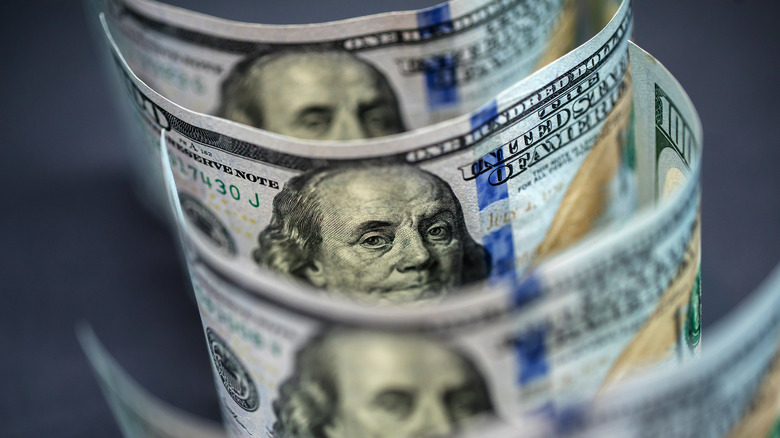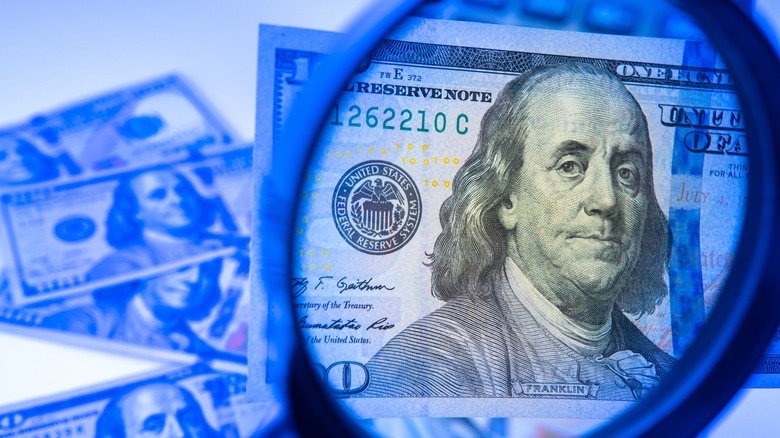How The Government Allegedly Uses Money To Spy On American Citizens
If there's one thing we've learned with the invention of YouTube and the self-proclaimed "experts" that came along with the video platform, it's that people love a good conspiracy. You could probably make something up right now based on the items to your left, post a video claiming they're used by the Illumilizard and the secret hand of the government to make the bullfrogs sterile or something, and you'd have a new following by morning. It's easy, but you probably shouldn't feed anything else into that culture. We have enough wild conspiracy theories as it is.
The Earth is flat and scientists have been lying to us for centuries, so children don't go trying to cliff dive over the edge. Planes produce trails of chemicals used for mind control. Every secret organization mentioned in a fiction novel actually exists and is in charge of running the world from behind the veil. Or, as Bank Note World points out, the U.S. $1 bill hides symbols from the Freemasons. Then, somewhere along the lines, people decided that American cash hid other secrets, like how the government can use the money in your pocket to spy on you. But how is that even possible? Well, it's probably not, but there are plenty of people out there who think it's happening right now, whether the scientific evidence agrees with them. Spoiler: it doesn't... mostly.
The magnetic strip in your bills
Pull out any bill of United States' currency larger than a $2 bill and hold it up to the light. You'll notice there's a fancy ribbon running vertically through the paper somewhere along the bill, and according to the conspiracy, this ribbon can do a number of different things depending on who you ask. Some of the statements collected by Snopes go so far as to say the government can use these bills in conjunction with a satellite to pinpoint your location. Yet, the tamer version of the "theory," as USA Today explains, says the ribbon is magnetic and that police can use a special device to tell exactly how much currency you're carrying on you at any given time. It doesn't seem like the most lucrative crime-fighting tool out there, but nobody wants the government to know if they're carrying around "new house money" or "I shouldn't have shopped at Amazon under the influence" money. It's an invasion of privacy. Plus, if the feds can track your location simply by you having money in your pocket, that's a big deal.
The latter really wouldn't be a big deal at all. There's so much currency floating around that they'd see millions of bills walking the streets and have no way of telling who was holding them unless they checked everyone. And, you know, you already carry around a GPS device in your cell phone. They don't exactly need to use money to track you.
Why it's really there
One part of the conspiracy that's based in truth is that there actually is a ribbon in bills greater than $2 bills in the United States, and as Cornell University explains, it's been there since 1990. Unfortunately for the conspiracy lovers out there, it isn't a "magnetic ribbon" at all. Though Physics Central will tell you that the ink used to print the bills themselves is ferromagnetic, the ribbon is nothing more than a three-dimensional security feature that's embedded in the actual fabric of the bills as one of several anti-counterfeiting measures (via USA Today).
This little strand is actually pretty neat. First off, if a $5, $10, $20, or $100 bill is without the ribbon, it's an obvious fake, but there are ways of counterfeiting bills that leave the ribbon intact. The only problem is it's the wrong ribbon. You'll notice, if you happen to be rich enough to have each of these bills, that the ribbon within them denotes the denomination of each bill. The $20 bills have a ribbon that says "20" whereas the $100 bill will say "100" and so on. This makes "washing" smaller bills of their ink and reprinting them exceedingly difficult because counterfeiters aren't able to wash the security ribbon. There's no way of passing off a $5 bill as a $100 bill to anyone who takes a close enough look, and without a security ribbon at all, the $1 bills might as well be useless to counterfeiters.
Could money be used to spy?
At the end of the day, people would like to know whether the cash in their pockets is feeding secrets to the government. After all, we've already established that the bills themselves are magnetic to some degree, even if the security ribbons aren't. So, could U.S. currency be used to spy on their citizens? The short answer is, "not really." The long answer is "possibly." Let's get into that one.
The magnetic qualities of U.S. currency, according to New Scientist, allow machines to tell when a bill is legit as it finally passes through the cash receiver after spitting your slightly wrinkled $5 out 15 times. Physicists at the University of Washington looked into if this could be used to count the bills on a person from a reasonable distance, and their study discovered that "yeah, it can." The magnetic inks could be sensed with a simple handheld metal detector in fact, and the more bills were there, the farther the distance in which they could be detected. Of course, it's nearly impossible to tell if these bills are $1 or $100 each because they all use such similar levels of the same inks.
The bottom line: Using devices to detect a few bills in your pocket would be mostly worthless to the government, but it's possible to detect large quantities of cash being moved, making it potentially useful in catching smugglers. So don't do that, and you're good.



